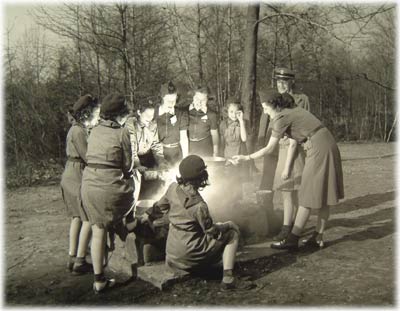Arsenal Gallery Exhibit
Queens Jewels: A History of Queens Parks
June 27, to September 5, 2002

Girl Scouts Around Camp Fire,Cunningham Park,Queens,1943
New York City Parks Photo Archive
|
Queens Jewels: A History of Queens Parks will be on display in the Arsenal Gallery through September 5th, 2002. |
The 7,000-acre Queens parks system is remarkably varied, as befits the most ethnically diverse county in the United States. But just a century ago, before Queens grew from a loose collection of villages into New York City's second most populous borough, Queens had no park system at all. It did have the barest of beginnings: a scattering of town greens and squares; a tradition of caring for trees dating back to the 18th-century establishment of the nation's first nurseries in Flushing; and one large park that was known, misleadingly, as the Brooklyn Forest.
The story of how these small seeds grew into Queens's impressive array of ocean beaches, wetlands, forests, playgrounds, pools, recreation centers, golf courses, historic houses and monuments begins at the turn of the last century. In 1895, the City acquired Forest Park, more than 500 acres in size. In 1911, Queens got its own Parks Department. Unfortunately, a year later Forest Park's woodlands were devastated by the chestnut blight, and the new Department found itself in the Queens tradition of tending to trees: removing the felled chestnuts.
Also in 1912 the Queens Parks Administration assumed its post at the Forest Park Overlook, with commissioner Walter Eliot attempting to impose orderly open-space planning over what had formerly been a haphazard and fractious process at best. The borough's first municipal playground, Ashmead, was established in 1914. A beautification project around the same time created landscaping at the Queensboro Bridge approaches.
In the 1920s, Queens's population doubled to more than a million residents, and park acreage kept pace, with acquisitions including the mostly natural 330-acre swath known as the Alley. In 1934, Robert Moses was appointed as the first citywide parks commissioner, and in the ensuing years he directed a massive expansion and upgrading of Queens parks facilities. To make way for the New York World's Fair of 1939-40, the city reclaimed the massive Flushing ash dump of Great Gatsby fame, and began its transformation into a great urban oasis. Astoria Park Pool, roomy enough for 6,600 bathers, opened in 1936. Rockaway Beach and its boardwalk were improved with state-of-the-art facilities and playgrounds along the shore.
In the postwar years, a string of parks in eastern Queens were improved, forming an emerald necklace that stretches from Flushing Meadows to the Nassau County border. After the 1964-65 World's Fair, a few of the fair buildings were adapted for reuse, such as the Hall of Science and the Singer Bowl, and the pavilion that became the Queens Zoo aviary. Shea Stadium opened in 1964 and welcomed the New York Mets to Queens. The St. Albans Naval Hospital property was acquired in 1977 as a park and renamed for civil-rights leader Roy Wilkins. In 1986 a family recreation center was built on the site.
In the 1980s and 90s the City redesigned and renovated many of the borough's older parks, and turned its attention to improving its stewardship of open spaces and natural resources. Udall's Cove was preserved as a pristine wetland, and the decommissioned Coast Guard base at Fort Totten was protected as a historic site. Flushing Meadows-Corona Park has become a mecca for the multitudes of all backgrounds and ethnicities who flock there to picnic, play soccer and attend its many cultural festivals. Contemporary art is displayed on the Astoria waterfront at Socrates Sculpture Park. And many of the old traffic triangles and village greens, which once constituted virtually all the parks Queens had, have been enhanced with new and varied plantings. Thus, in its first century the Queens parks system has become a welcome setting for many jewels.
The photographs are from the New York City Parks Photo Archive and Parks Department collections, along with images on loan from the Queens Central Library, Long Island Division.
The exhibition is curated by Director of Art & Antiquities Jonathan Kuhn. Both the exhibition and historical brochure are sponsored by BP.